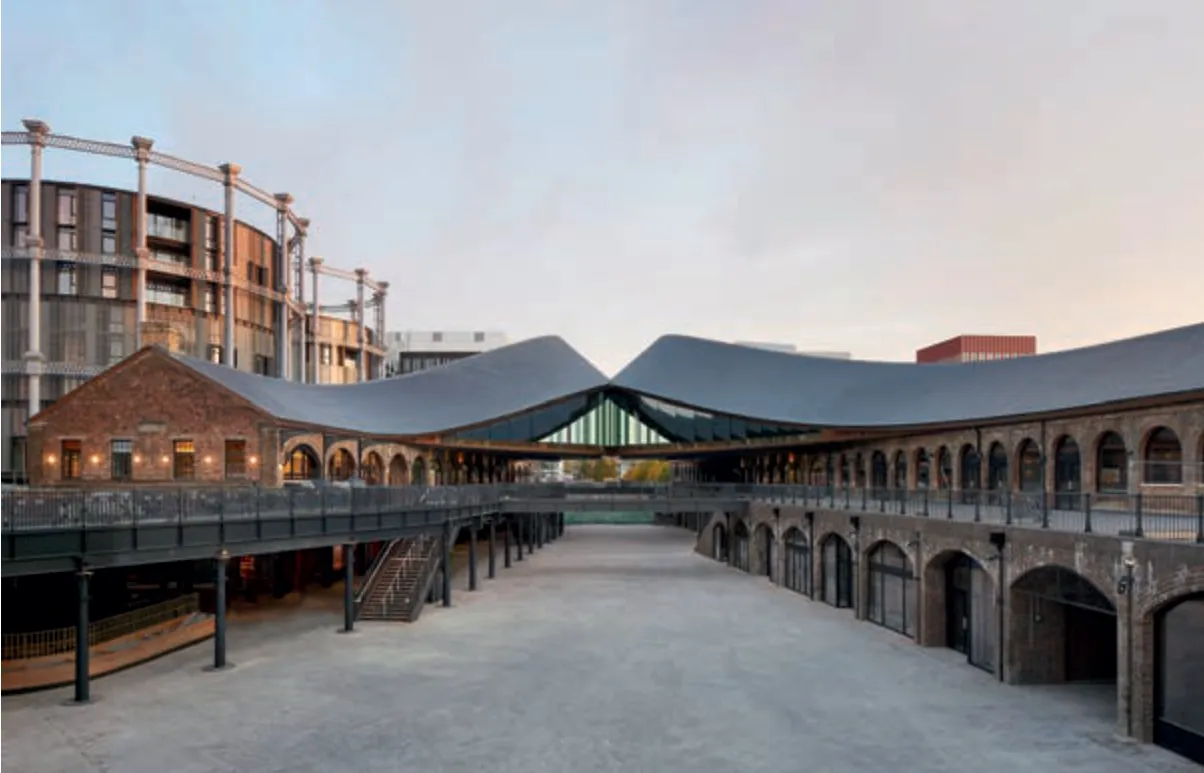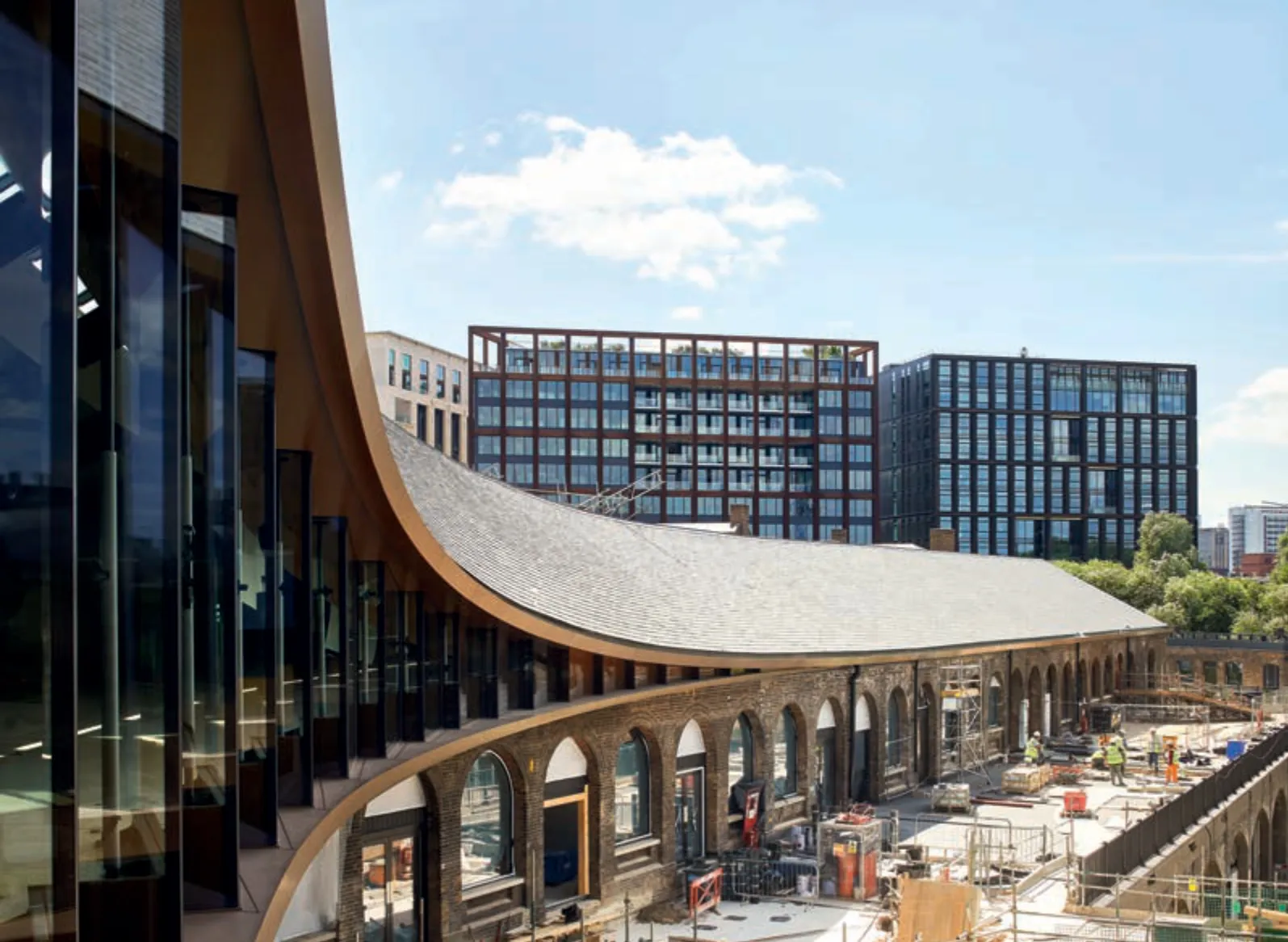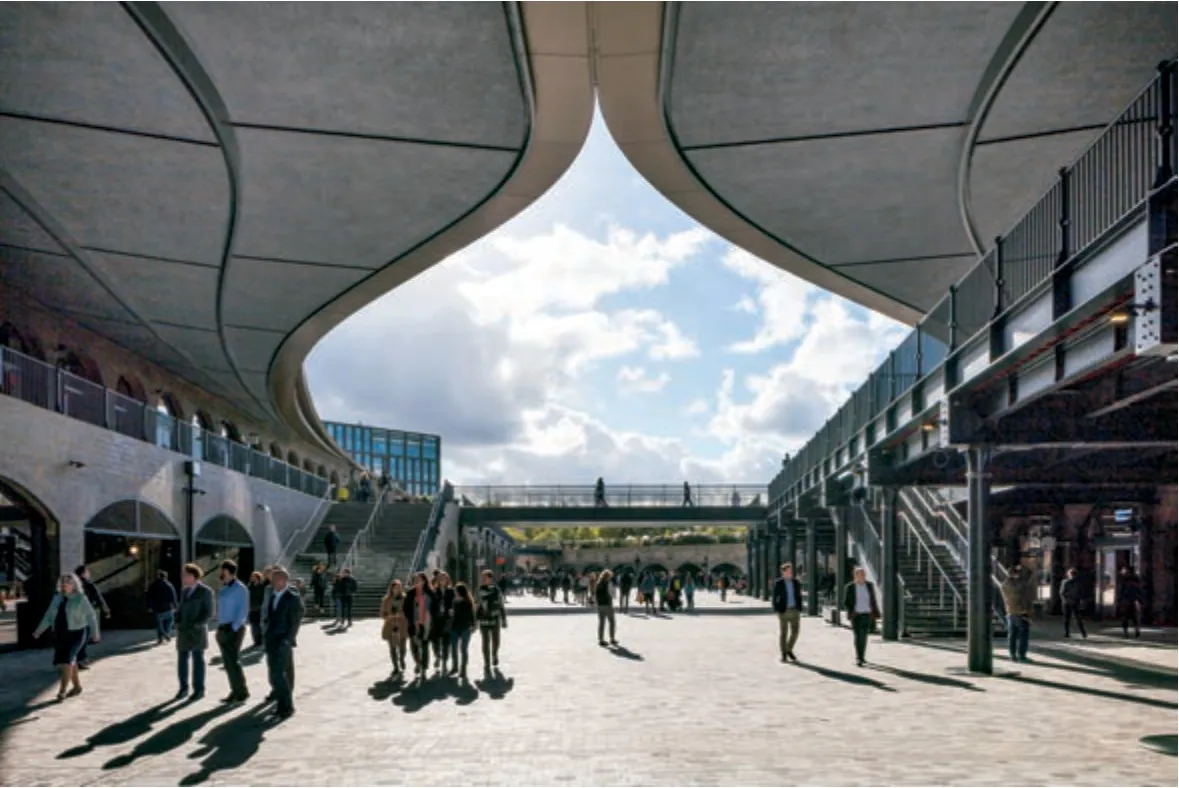通过对承重结构的批判性再解读实现适应性再利用:赫斯维克工作室在英国伦敦国王十字街区的实践
2019-11-26阿尔伯托博洛尼亚AlbertoBologna
阿尔伯托·博洛尼亚/Alberto Bologna
朱琳 译/Translated by ZHU Lin
作者单位:都灵理工大学/Politecnico di Torino
译者单位:爱丁堡大学/University of Edinburgh
记忆与再生
栏目主持:阿尔伯托·博洛尼亚,米凯利·博尼诺,皮埃尔-阿兰·克罗塞特
Memory and Regeneration
Column Editors: Alberto Bologna, Michele Bonino, Pierre-Alain Crose
在当代,很少有建筑作品可以在被认可为专业设计实践佳作的同时,引发对重大理论问题的串联思考。正因如此,位于伦敦国王十字街区的铁路建筑遗产的再开发是一个值得注意的案例研究。我们期待从中提炼出批判性方法论的重点,并且使用建筑设计领域的特定分析工具进行验证。
这一干预所提出的关键问题不在于形式主义,也不在于所使用的特定的建造技术,或是促成了建筑群所在整个区域的重新定义的决策过程,而是在对这一类建筑和城市再开发项目的分析中,相对于设计实践,建筑评论扮演了怎样的角色?但最重要的是,对评论家来说,有哪些可用的操作工具来促进对有效的建筑设计策略的宣传,以影响未来全球范围内适应性再利用领域内的专业实践?
为了回答这些问题,我们必须思考,如何传播有关现有建筑再利用的出色设计实践,使其关联到聚焦于建筑物建构面向的批判性方法论,以便这些建构面向能够从概念上被分解、拆卸,从而带来对最终建造的物质本质和程序面向的明确解读。这些现有建筑是出于务实的功能性目的而建造的,如今由于它们独特的构成和形式、久远的年代、所处的地段,抑或由于它们自然而然地成为了记忆保管者而具有了实际的纪念性地位。
该项目是位于伦敦的赫斯维克工作室的作品,该工作室所主持的重要项目分布在包括英格兰、美国、南非、中国在内的世界各地。通过该项目,赫斯维克工作室明确了其对旧工业建筑再利用的强烈的兴趣和敏感度。位于开普敦的由废弃筒仓改造而成的非洲塞茨当代艺术博物馆建成之后,这一设计主题最近给事务所带来了全球知名度。赫斯维克工作室的再开发所在的区域类似于一个人工“岛”,它有着累赘的工业遗产,并试图通过建筑、基础设施和公共空间的改造而创造出新的城市特色。过去,制造业隔离了该区域,使之在形态上与其周围的街区截然不同。赫斯维克工作室的项目位于由伦敦的基础设施网络形成的一条城市沟壑的南部。通往圣潘克拉斯车站的铁轨位于基地的西侧和北侧,约克路在它的东侧,路面之上是来自国王车站的铁轨,南侧的摄政运河将这一区域从周边以住宅建筑为主的城市肌理中分隔出来。再开发和转化项目已经在这一区域逐渐展开。2011 年以来,南部俯瞰谷仓广场的旧仓库已经成为了中央圣马丁艺术与设计学院的新校区,旧煤气筒被改造为公共空间。北部对着路易斯·丘比特公园的区域目前是阿卡汗大学穆斯林文明研究中心。在这样的背景下,2014 年赫斯维克工作室受到国王十字中央有限公司的委托,来重新考虑俯瞰摄政运河的场地。建于 1850-1860 年间的3 座仓库采用了当时流行的维多利亚风格,是这块场地的最大特征。
通过对3 座建筑和它们所围合的开阔庭院的改造,这个总部在伦敦的事务所成功地从建筑和功能上重新定义了整个区域。原来的仓库综合体储存着从英格兰各地运来的煤炭,再通过船舶和马车分发到伦敦的不同区域。在经历了缓慢而不可逆的衰退之后,它原有的功能已经丧失。过去的几十年间,这些建筑最早是由小型工业机构占用,后来被当作仓库,最终被经营为夜店,并在1990 年代之后被逐渐遗弃。建筑师说,他们“想要保留工业建筑独特的肌理和历史,同时创造一个统一的崭新的公共空间和零售综合体”,目标是“将荒废的建筑和长条的线状场地转变为热闹的零售区域,让人们可以自在地聚会和闲逛”。
在评论家为了积极助力对优秀建筑设计实践的宣传而必须要参考的理论教条的定义中,我们不应忽略对他所面临的“任务”的定义。考虑到国王十字所进行的再开发的特殊性,这样的“使命”理应被理解为一种能力——能够认识到建成遗产的复杂性,从而得以拓展和分析建筑与城市开发项目所体现出的问题和潜力。这种理解理论的方式与专业实践关系极为密切,不出意外地赫斯维克工作室在围绕场地适应性再利用的项目中运用的不同操作体现了这一方式。如果说塞茨非洲当代艺术博物馆的空间品质是通过在筒仓内壁上做减法的复杂操作而达到的,在伦敦的新综合体中,建筑师们则利用了原有屋顶承重结构的模块化和序列性来增加一部分适合于新的商业功能的空间。两个案例所使用的方法都根植于对原有建筑的物质特性的深刻理解,其特性将会决定未来所有的建筑设计的选择。同样地,评论家们所使用的分析方法,必须始于每个建筑作品中构造上的、类型化的、形式上的独特性,如此,这些文章才能被看作是对这些足以影响未来专业实践的操作工具的有益宣传。

1 南侧鸟瞰/Aerial view from south(摄影/Photo: Luke Hayes)

2 从南侧望庭院/View of the courtyard from south(摄影/Photo: Hufton + Crow)
In the field of contemporaneity, there are few architectural episodes that make it possible to question and link together major theoretical issues while being considered examples of good professional and design practices. The redevelopment of the heritage rail buildings located in the King's Cross district of London is, therefore, a case study worthy of note if we also analyse it with the aim of refining the focus of critical methodologies and testing them using specific analytical tools in the field of architectural design.
This intervention raises crucial questions that go beyond the formalisms, specific construction techniques used or decision-making processes that have led to the new redefinition of the entire area within which the buildings are included: what is the role of architectural criticism in relation to design practice in the analysis of an architectural and urban redevelopment project of this kind? But above all: what are the operational tools available to critics to contribute to the dissemination of valid architectural design strategies capable of influencing future professional practice in the field of adaptive reuse all over the world?
To answer these questions, we have to consider how the transmission of good design practices related to the reuse of existing buildings - built for pragmatic utilitarian purposes and now elevated to the status of actual monuments due to their compositional and formal peculiarities, their age, their location within the city or due to the fact that they have become the involuntary custodians of memories - must relate to critical methodologies that focuses on the tectonic aspects of buildings, so that they can be ideally dismantled and broken down, with the consequent definition of both the material essence and the procedural aspects that led to their construction.
The project is the work of the Heatherwick Studio in London, which has been responsible for significant projects all over the world, from England to the United States, from South Africa to China. For this project, the Heatherwick Studio unequivocally confirms a strong interest and sensitivity towards the reuse of former industrial buildings, a design theme that has given it a recent worldwide reputation following the completion of the Zeitz Museum of Contemporary Art Africa, housed in an abandoned silo in Cape Town. The area of London where the Heatherwick Studio's redevelopment is located is a sort of artificial "island" with a cumbersome industrial past, intent on pursuing the progressive creation of a new urban identity through the transformation of buildings, infrastructures and open spaces. The area's original manufacturing vocation separates it and makes it morphologically very different from the other parts of the city around it: the Heatherwick Studio project is located south of an urban ravine generated by London's infrastructure network. The railway tracks serving St. Pancras station to the west and north, York Way to the east - over it, the tracks from King's Cross station - and Regent's Canal to the south separate this area from the rest of the urban fabric, most of which are residential buildings. Redevelopment and conversion programmes have been launched progressively within the area. Since 2011, the southern part has been home to Central Saint Martin's College of Arts and Design, in the former warehouses overlooking Granary Square, and the old gasometers have been converted into public space. The northern part, facing Lewis Cubitt Park, currently houses the Aga Khan University Institute for the Study of Muslim Civilisations. Within this context, in 2014 the Heatherwick Studio was commissioned by King's Cross Central Limited Partnership to radically rethink a site overlooking Regent's Canal, characterised by three warehouses built between 1850 and 1860 in the Victorian styles that were fashionable at the time.

3 区位平面/Site location plan

4 首层平面/Ground floor plan

5 庭院,西侧立面/Courtyard, west façade(绘制/Drawing: Heatherwick Studio)

6 新型钢结构示意/Structural diagram of the new steel structure (摄影/Photo: Heatherwick Studio)

7 工地,新型钢结构的组装/Building site, assembly of the new steel structure(摄影/Photo: Heatherwick Studio)

8 新屋顶和底层现有砖石结构之间的连接/Connection between the new roof and the underlying existing masonry (摄影/Photo: Hufton + Crow)

9 庭院内立面细部/Inner façade detail (摄影/Photo: Heatherwick Studio)
在以上方面,原国王十字仓库的再开发证实了它的转变潜力,体现在对以序列重复的结构元素为特点的建筑的适应性再利用。面对庭院的两座现有建筑的屋顶坡度从二维的平面转变为三维的立体:这个精彩的形式操作赋予了新综合体独特的特征,增加了可销售的表面面积,视觉上连接了两座现存的仓库,并且覆盖了开阔的大内院的一部分。然而,它不应该仅仅被视为一个出色的设计实践、一个可以被运用到其他类似情况中的设计案例,而是一种设计工具,它促成了从现有的两个翼部生长出来的两个新体量的寄生性嵌入,势必会吸引建筑评论家们的目光。赫斯维克工作室和奥雅纳公司的合作催生了一个崭新而复杂的自支撑结构系统的概念,其不仅可以融入已有的墙壁和金属结构,还可以复制它们的间距、形态和几何关系——换句话说,它们最核心的本质。支撑现有建筑顶层的52 个新钢柱,隐藏在古老的砖材和钢材之后,由混凝土墙和核心筒支撑着;每一个弯曲的新带状屋顶由20 品钢型材组成,一端由螺栓固定在4 个钢桁架上,另一端固定在柱子上。原有的砖石建筑成为一个藏宝箱,收藏着旧的和新的结构部件:它们融合为一个理想的同质的有机体,使得屋面的复杂扭曲和凸出成为一个几乎自发的形式操作、同一个架构在几个世纪中自然演化的结果。8 万片屋顶瓦片强调了这一合乎逻辑的演化,它们与维多利亚风格的原始建筑所使用的瓦片来自于同一家威尔士采石场的石板。

10 从北侧望庭院/ View of the courtyard from north(摄影/Photo: Luke Hayes)

11 建筑顶层室内/View of the inner space at the top level of the buildings(摄影/Photo: Hufton + Crow)
这并不是简单的形式主义,而是真正的建筑演化的姿态。只有通过巧妙地对建筑和屋顶的结构系统的批判性再诠释,并借助于建筑师展现的技巧得以落实,这一演化才能成为可能。建筑师们有条理地分解现有建筑以理解它们作为物质实体的本质,并将建造时使用的构造过程转化为真正的设计工具,最终运用到单体建筑以及城市整块区域的重建之中。□
With the refurbishing of the three buildings and the large open courtyard bordered by them, the London-based Studio is contributing to the architectural and functional redefinition of the entire area. This former warehouse complex has undergone a slow but inexorable deterioration since the premises lost their original functions, which aimed to store coal brought in from all over England for distribution throughout the London area by barge and cart. Occupied, over the decades, initially by small industrial establishments, then warehouses and, finally, nightclubs, the buildings have been progressively abandoned since the 1990s. The designers say that they "wanted to celebrate the unique texture and history of the industrial buildings while also creating a unified new public space and retail destination", the goal being "to transform the dilapidated buildings and long, linear site into a lively retail precinct where people could gather and circulate with ease".
Within the definition of the theoretical dogmas to which the critic must refer in order to contribute constructively to the dissemination of good architectural design practices, we cannot ignore the definition of his "task", a "mission" which, when linked to the specificities of the redevelopment carried out at King's Cross, has to be understood as the ability to recognise the complexity of the built heritage in order to expand and analyse, as a consequence, the problems and potentials expressed by the architectural and urban redevelopment project. Radically bound to professional practice, this way of understanding theory is not surprisingly reflected in the different approaches adopted by the Heatherwick Studio in projects that embrace the field of adaptive reuse. If spatial quality at the Zeitz Museum of Contemporary Art Africa is obtained thanks to a sophisticated action of material subtraction from the interior walls of the silo, at the new London complex, the designers take advantage of the modularity and seriality of the load-bearing structures of the original roofs to accomplish an action of volumetric addition suited to the new commercial programme. In both cases, it is an approach rooted in a deep material knowledge of the building, the characteristics of which will determine all future architectural design choices. Likewise, critics must implement an analytical methodology that begins with the constructive, typological and formal peculiarities of the individual piece of architecture so that his work can be considered useful to the dissemination of those operational tools capable of influencing future professional practice.
In these terms, the redevelopment of the former King's Cross warehouses exemplifies the transformative potential, seen in terms of adaptive reuse, of buildings characterised by the serial repetition of structural elements. The pitches of the roofs of the two existing buildings facing the courtyard are transformed from two-dimensional slabs into three-dimensional objects: this brilliant formal solution conceived to uniquely characterise the new complex, increase the saleable surface area, visually connect the two existing warehouses and partially cover the large open courtyard, should not, however, be interpreted as a good design practice in itself, to be used as an example for the design of other similar situations. Instead, it is the design tool that implements the parasitic insertion of the two new volumes that emerge from the two existing sleeves that must attract the attention of the architectural critic. The collaboration between the Heatherwick Studio and Arup leads to the conception of a new and complex self-supporting structural system capable not only of integrating with the existing walls and metal structures but also of replicating their bay, morphology and geometry: in other words, their essence. 52 new steel columns cross the top of the existing buildings, concealed behind aged brick and iron, and shored up by concrete walls and cores; each of the curving new roof ribbons is formed of 20 steel sections bolted onto four trusses and tied back to the columns. The original masonry work became a treasure chest that preserves both old and new structural parts: their incorporation into an ideal homogeneous organism makes the sinuous distortion and extrusion of the roof pitches an almost spontaneous formal gesture, the result of a natural evolution of the same architecture over the centuries. A logical evolution emphasised by the 80,000 roof tiles made of slate extracted from the same Welsh quarry as those used for the original Victorian buildings.
This is not a mere formalism but a real architectural evolutionary gesture that became possible only with an intelligent, critical reinterpretation of the structural system of buildings and roofing, put in place thanks to the skill displayed by the designers in analytically breaking down the existing architectures to understand their material essence, turning the tectonic processes used at the time of construction into real design tools for the regeneration not only of individual buildings but of an entire part of the city.□
